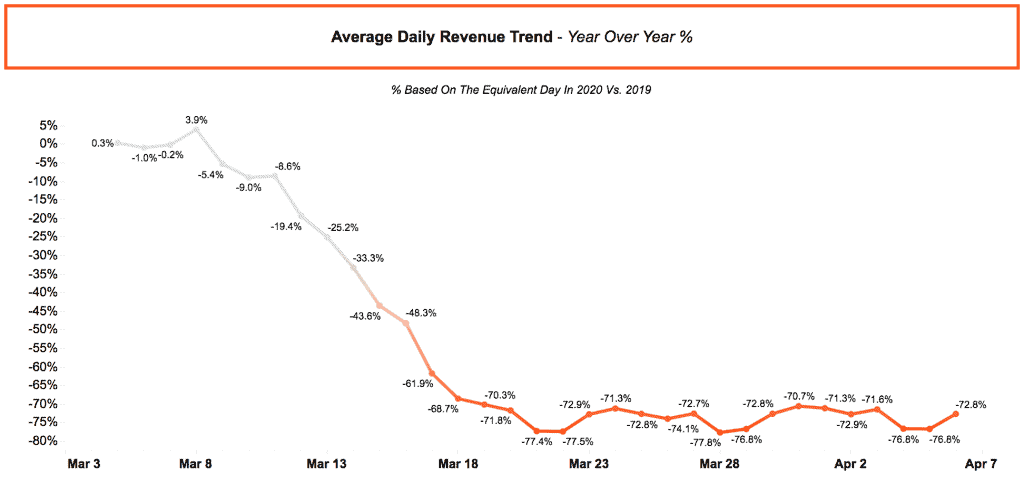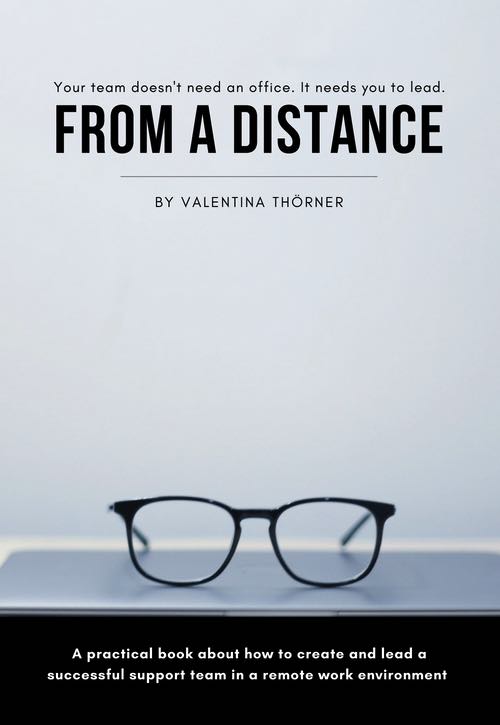Throughout the country and around the world, an unfortunate side effect of quarantine is hitting companies hard: major drops in revenue are forcing the difficult decision of layoffs and furloughs.
According to a survey conducted by business research group, The Conference Board, more than half of US executives plan layoffs and furloughs due to the Coronavirus pandemic.
Specifically, in the survey, a shocking 54% of executives said they plan to lay off or furlough workers, and 43% are planning pay cuts. It's ugly out there.
Quarantine hits hard.
Many well known companies are hurting. Outdoor retailer REI furloughed all of its employees along with pay cuts for leadership across the board:
Postcard From REI:
— Mark C. Crowley (@MarkCCrowley) April 8, 2020
Its #CEO will take no pay for 6 months & give up his entire 2020 bonus.
Board members will take no fee for 6 months.
SR leaders will take a 20% cut & have zero bonus.
All employees will be furloughed (no pay/with benefits) until July 15!#Leadership #COVID
Meanwhile, restaurant software maker Toast took similar measures, as stated in a recent letter by CEO Chris Comparato:
"This morning at Toast we shared the agonizing decision to reduce the size of our company by roughly 50 percent through layoffs and furloughs as a result of the COVID-19 health crisis.”
With an average decline in restaurant revenue of 73% since the shutdown began, Toast had no choice but to cut back:

Similarly, restaurant discovery and review site, Yelp, laid off roughly 17% of its staff with roughly the same number of furloughs:
Yelp lays off 1,000 employees and furloughs 1,100 more https://t.co/qkoB9CMm3I
— Romain Dillet 🙃 (@romaindillet) April 9, 2020
What do all of these have in common?
They're cutting once, and cutting deep. They're doing one big layoff that (hopefully) ensures it will be the only layoff they need to do.
Are you ready?
If you're in any industry that is directly affected by quarantine, or those companies are your customers, you're likely going to have to lay off part of your team as well.
You might be reading this with plans already in place and you're wondering the right way to go about it (especially since it's going to have to be done remotely).
If you go about it the wrong way, you won't just lose part of your team, you'll also lose the trust and motivation of the employees you keep.
This is why today's post focuses on the tough topic of layoffs; we want to help you handle this the best way possible.
How to Do Layoffs the Right Way
Layoffs are always hard. No one enjoys them. However, if the survival of your company is at stake, you have to do them.
Use our guide today to help you navigate this difficult decision.
Table of contents
- Cut once, cut deep
- How will your team react to layoffs?
- How to help your team after a layoff
- How to do layoffs remotely
- Additional resources
Cut once, cut deep
One thing every experienced executive seems to agree is that if you're going to survive, you have to cut once, and cut deep to survive.
In The Hard Thing About Hard Things, Ben Horowitz recalled when legendary venture capitalist Doug Leon asked him how he brought Opsware back from near death:
"After I took him through the details– including several near bankruptcies, a stock price of $0.35 per share, unlimited bad press, and three separate layoffs where we lost a total of four hundred employees– he was most amazed by the layoffs.”
Leon remarked that in his twenty-year experience, he had never once seen a company come back from consecutive layoffs:
"He confessed that he'd bet against that every time.”
Dalton Caldwell, Partner and Head of Admissions at Y Combinator, shares that sentiment. He says multiple layoffs are, "a form of cascading failure. Do one layoff, but much much deeper than seems correct. Do it decisively. Do it so that you get profitable.”
In his post on surviving the 2008 recession, written as advice to his former self he said:
"In your case that is something like a 70% cut, not a 5-10% cut. Yes you read that right: a 70% cut.
Cutting once and cutting hard allows you to reassure the people that are still here that you are truly profitable and won't need to do it again. Doing a layoff and remaining unprofitable and counting on fundraising to save you is a stupid plan.”
Many companies are making their tough calls right now. Your company is probably no different. You have to think about it as one, hard measure now to make sure you make it through the storm.
If you end up doing a second round of layoffs, you'll break the confidence of your team. They'll be scared there will be more layoffs coming, affecting their ability to focus and work hard. It can also lead them to interviewing for jobs and leaving on their own in an act of self-preservation and fear.

How will your team react to layoffs?
It's not enough to just make one sweeping cut and consider your layoff plan complete. You then need to think about how the remainder of your team will see the decision from their perspective.
Failing to consider how your layoffs are viewed can come back to bite you in the worst ways.
In The Hard Thing About Hard Things, Horowitz goes on to give what he says is his most important advice, which might be more relevant today than ever before:
"When you're making a critical decision, you have to understand how it's going to be interpreted from all points of view.
Not just your point of view and not just the person you're talking to but the people who aren't in the room, everybody else.
In other words, you have to be able, when making critical decisions, to see the decision through the eyes of the company as a whole. You have to add up every employee's view and then incorporate that into your own view. Otherwise your management decisions are going to have weird side effects and potentially dangerous consequences.”
Horowitz goes deeper into this in the amazing Stanford University talk below. It's well worth the listen, especially now:
If you don't take the right steps during a layoff, those actions can affect the trust, morale, and engagement of the team moving forward and will make it very hard to get any of those things back.
When you do a layoff, your remaining team needs your leadership more than ever. They need you to lead them through these hard times with a vision for the future, whether that's refocusing your business to a better opportunity, or staying the course so you can rehire those laid off.
How to help your team after a layoff
If you're committed to a layoff, what do you do next? How can you build that confidence and trust with your team you've kept?
In NetApp co-founder Dave Hitz's book, How to Castrate a Bull, he talks about how the true test of a company's culture comes during tough times.
There's nothing tougher than layoffs, which is why Hitz explained specifically how to properly handle them in 3 crucial steps:
1. Share the pain
Tell everyone how difficult it was to make the decision to lay off part of the team, and express empathy for what those let go must be going through.
Then, show your humanity. Your team needs to know this wasn't easy for you to do, either.
2. Show how and why you made the decision
Everyone you hire is an adult, and can understand tough calls must be made sometimes. Treating your team with the respect of showing how you arrived at the decision is key to helping them understand what's happening and why you made the call now.
Prepare answers to the following:
- How has the shutdown specifically affected your company already?
- What caused the final decision to move forward with the layoff?
- With this change, how long does the company have to turn things around?
By preparing and then sharing answers to these and similar questions, your team will see that it's likely a necessary call. It can also motivate them to want to help turn the corner.
3. Give them hope
Importantly, after all of this bad news, you need to give your team a reason to have hope. Tell them your vision for how things are going to move forward and what your goal is to get through this.
This will help funnel the difficult emotions tied to the whole situation toward that new initiative and spark new motivation.
Doing so makes you an above average leader, as according to a recent Gallup survey:
"Only 39% of U.S. employees strongly agree that their employer has communicated a clear plan of action in response to COVID-19.”
And this goes for all layers in the organization as only 48% of employees "strongly agree that their immediate supervisor keeps them informed” about what's going on in the org as it relates to the shutdown's impact.
Don't be like those managers leaving their team in the dark. You need to offer a clear path forward for your team.
Human beings are incredibly resilient. We'll get through this, and your team needs your leadership to do so.
By laying down a clear plan, you'll be giving your team something to rally behind. You'll also be giving them a sense of stability, which is invaluable at a time like this.
Now, you have a plan for a single, deep cut and a detailed walk-through of what, why, and hope for the future, you just have one last problem: how you're going to get through this layoff.
Specifically: how you're going to do it remotely.

How to do layoffs remotely
Layoffs are already a challenge, but what if you have to do them remotely?
With the current shutdown still looming over virtually every industry in the country, managers have no other option but to perform layoffs remotely.
How does that change things? And what do you have to be mindful of when laying off employees remotely vs. in person?
To get some expert insights, we spoke with Mark C. Crowley, author of Lead From The Heart: Transformational Leadership For The 21st Century, and Valentina Thörner, Head of Product and Remote Culture at Klaus.
They were gracious enough to take a few minutes to offer their knowledge for the rest of the Lighthouse community.
We talked about:
- How to let employees go in a compassionate way
- How to improve morale after a layoff
- Specific tactics for when you have to let people go remotely
Here's what they had to say:
1) Knowing the quarantine means you can't do anything face to face, how would you let people go in a compassionate way, and reassure and motivate your remaining team members?
Letting people go feels akin to breaking up over a phone call. Any reasonable, empathetic human being just wouldn't do it.
Until you had no choice.
Valentina Thörner has been managing and leading remotely for years, first at Automattic, and now at Klaus. She wrote a book about her experiencing managing remotely, too.
Regarding this question she shared advice similar to what Dave Hitz suggested:
"Transparency is the key here. If your employees know how much the company is making, and how much costs there are associated with running the company, then it's easy to understand when the breaking point is near.
It does not make the fact of losing a job easier, but it can certainly help the employee to understand that it was not their fault.”

To reinforce your statement that it's not their fault, she suggest you have a recommendation letter prepared, and to offer being available as a reference for the employee's future job search.
This same transparency should then extend to those who continue with the company, she says:
"Share the plans you have to survive the crisis and how they can influence the outcome. Now more than ever employees and leaders need to work together to get through this crisis - whether in office or through remote communication.”
If you don't extend this same consideration to those employees you keep, you'll create a lot of problems, as Mark Crowley warns:
"Fear is a powerful motivator and we're seeing leaders lop off employees because it's an expedient cost-save.
But all employees who remain in these organizations (and anyone the company later seeks to recruit) will see through leadership's motivations, and their trust will be permanently eroded.”
If you have to let people go, Crowley suggests:
- Be as generous with severance as possible
- Tell these workers you want them back and will come calling for them
- Clearly explain the decision is about the survivability of the business and nothing to do with them or their performance.
As you can see, whether the decision is made in an office or remotely, all the experts agree you need to be transparent and clear about the decision.
2) How can remote leaders tell if they have work to do, and how can they help improve morale after delivering bad news like layoffs?
Crowley passionately emphasized to me in our discussion that, "for every person you must let go, a one-on-one phone conversation is required.” Letting people go through email, voicemail, or the worst, a chat message, will only agitate an already difficult situation for them. It will make you look heartless.
You can see from the outrage over Bird's mass-layoff over Zoom just how far reaching the damage can be from a poorly handled layoff.
However, as important as the conversation is with each of your team members you are letting go, you also need to be ready to immediately communicate with your remaining team.
To help improve morale after announcing layoffs, Thörner recommends you immediately move to share the changes with your team:
"Explain the situation, explain your plan and how the reduced labor costs fit into that plan, and focus on how going forward we are going to get through this together.”
Unfortunately, even doing that you'll still have some fallout to deal with.
This is why Crowley recommends you ask those you speak with to wait an hour or two before talking with coworkers to give you time to talk to everyone. You can't guarantee they'll listen, but if you've been fair to them in the discussion, they're more likely to honor such a request.
Beware of back-channels.
Even with a request like Crowley suggests, it's likely that very soon an employee who was laid off will contact friends and colleagues through a back-channel (or a friend who sees their email or chat is disabled will contact them). They'll tell them about how you let them go and before you can blink, the news will have gotten around that could have an enormous positive or negative impact on the trust and morale of the entire team moving forward.
Thörner says there's really no way to avoid this kind of back-channel gossip in a digital environment, when even tools like Slack allow for private channels, not to mention Whatsapp/Hangouts/etc.
"You can't avoid these back channels, and you won't ever be aware of all of them. But if you have a good relationship with your team and one or two trusted allies outside your own hierarchy level, sooner or later you will get DMs with feedback.”
Even more than that, though, she says your 1 on 1s are crucial in figuring out how the news was received:
"My favorite question is ‘Are there any rumors you think I should be aware of?' And then wait (even if you got an instant ‘no' as an answer).”
As much as you may hope one difficult day of layoffs and then explanation to your remaining team is all you need, the fact is it's an ongoing process.
Assume you need to continue building confidence, answering questions, and dispelling rumors in the days and weeks that follow. As Thörner suggests, your 1 on 1s are one of the best places to discuss people's true feelings and questions about it.
Further reading: Use our crisis leadership questions to help improve your 1 on 1s in this situation.
3) The tactics & mechanics of letting people go remotely
As difficult as it is, there's no one else that should be making these video calls than you, and possibly an accompanying HR rep.
Thörner says a good rough outline for these calls is:
- "[Explain] the current business situation and the reason for the lay-offs
- Share what exactly that means for the person in question, e.g. furloughing, letting go completely, let go but paying health care premiums until May
- Additional information that you can help the person with: sending them an email with the last appraisal so they can use it in their job hunting, outlook on whether in the future you might be able to rehire them."
She suggests that if you have a group of 5-8 you need to let go, you do them individually and all on that same day.
Crowley adds some important nuance to these calls to help avoid:
"During these calls, managers must ask these employees to not share the news (in a call, text, email etc.) with any co-workers for 1 full hour (or for how long you estimate it will take to speak to everyone).
Once everyone being laid off is told, then bring the team that will remain together and inform them of the layoffs [and] an explanation of why it had to be done.”
Even if you have a large team, it's important to keep the personal touch, as Thörner emphasizes:
"Even if you have to do a mass layoff, it is super important to give each employee at least 5 min of your undivided attention to share how much you appreciated working with them and that you wish them the best, even if the circumstances are dire.
There will be tears, most likely, but not giving everyone at least a bit of personal time would be a lack of respect for their humanity."
At the center of all this is remembering there are other humans on the other side of the call. It stinks you can't do it in person, but you can still give them some of your personal time and attention over a video call.
Even small gestures of respect can go a long way toward making the difficult situation feel better.
Alternative tactics to consider when doing a layoff
Crowley suggests taking it a step further and telling the entire team of the decision in advance of the actual layoff, so it's less of a shock:
"People process bad news over days, not minutes, so advance notice will likely put many of them into fear — but also into a mindset of ‘what would I do if I'm someone being laid off?'
That's a better place to be if they're later let go. They're much better prepared to move forward.”
This insight is key also for your team that remains after layoffs; they will still be processing the layoff days later, so keep checking in going forward to answer their questions and continue to build their confidence.

He also suggests making sure you have to do layoffs. There are alternatives:
"In some organizations, workers might all agree to a pay (25-50%) cut for the next few months (equivalent to the percentage of workers being considered for a lay off) just to stay working.”
If everyone on your team can come to a similar agreement, and you're at the level in your organization that you can make such a call, you'll be able to keep the team together.
This can be significant as a morale boost and make your rebound that much faster; once the shutdown ends, you simply give everyone back their original compensation, as opposed to being short handed and needing to go through hiring again.
I've seen a few companies do this recently, sometimes with caveats like a 20% pay cut, and Fridays off. (Note: To respect confidentiality, I cannot name the companies)

Your team needs you.
Now more than ever, your team needs your words, your vision, and your guidance.
Layoffs are never easy and the circumstances of today are unlike anything we have ever experienced. Regardless, you owe it to your team– both those you have to let go and those staying on– to lead them as best you can through these tough times.
Let your message and your plan for the future become a rallying cry to the rest of the team that remains; as Crowley reminds us, the goal should include the belief that, "If we do a good job, we'll be able to hire back the people we had to lay off.”
And most importantly, no matter what happens, Mark reminds us to lead from the heart:
"Never forget that how you make people feel in these moments is what they'll most remember. Be as humane, thoughtful and kind as you possibly can.”
We hope these tips and insights help you navigate the unimaginable challenge of performing layoffs and furloughs.
And take a look at these posts for more on how to help your team during this crisis:
- Leading Happy Teams Through Crisis: 5 Ways to Keep Your Team Happy and Motivated in a Recession
- Crisis Leadership: 18 Questions to Ask Your Team to Thrive in Difficult Times
- For a detailed walkthrough for executives and founders to do layoffs, this post from Andreesen-Horowitz is very helpful.
And if you need help with those challenging 1 on 1s post-layoffs, Lighthouse is purpose built to help you.
It comes with with questions to support your newly remote team, guide you through crisis leadership, and ensure you build momentum from meeting to meeting. Start your 21 day free trial here.
Thanks to Mark C. Crowley and Valentina Thörner for offering their knowledge and wisdom to make this post possible.
More about Mark C. Crowley:
Mark is the author of Lead From The Heart: Transformational Leadership For The 21st Century and host of the Lead From The Heart Podcast now heard in 138 countries. Connect with him on his website, markccrowley.com.
More about Valentina Thörner:
Valentina is Head of Product and Remote Culture at Klaus, the conversation review and Q&A platform for CS teams. Connect with her on her website, valentinathoerner.com.
Are you growing as a leader? Are you building the skills you need?
Whether your team is in office with you or remote, Lighthouse Lessons can teach you the skills you need to better lead, motivate, and grow your team. Let us help you navigate the unique challenges of being a leader like we helped Daniel by learning more and signing up here.









